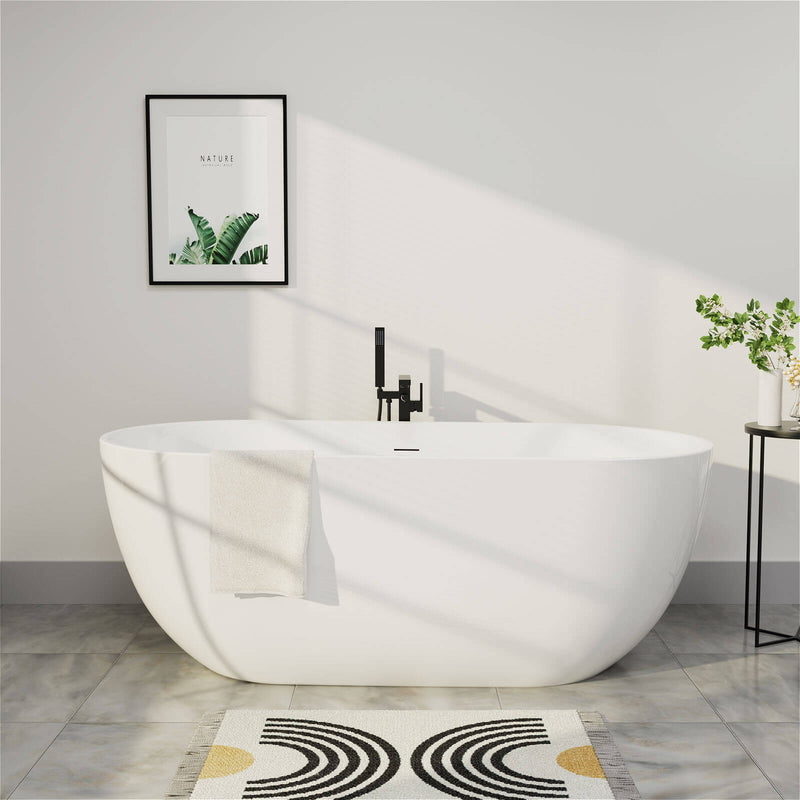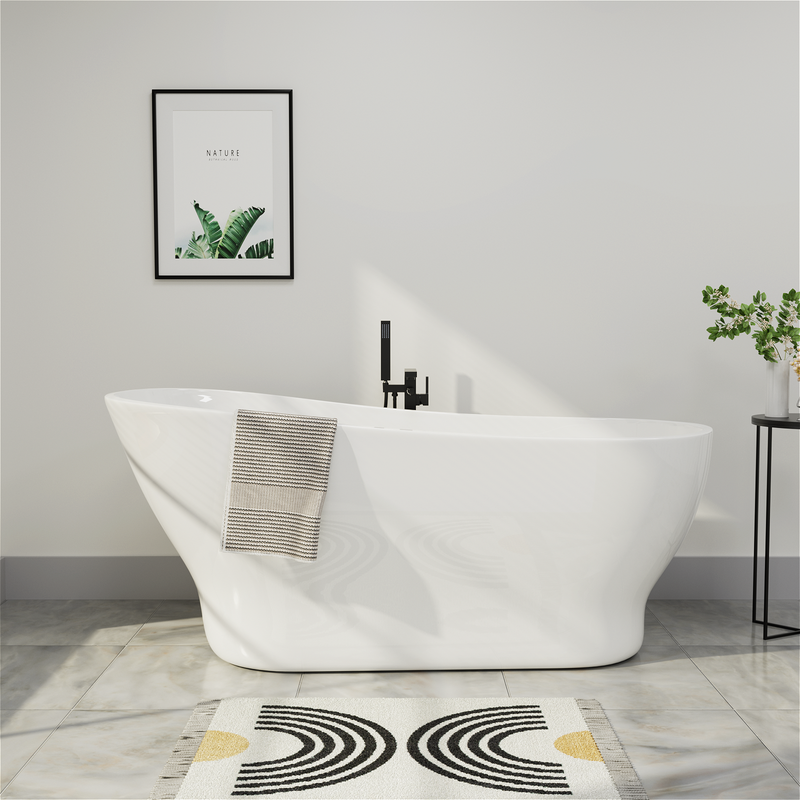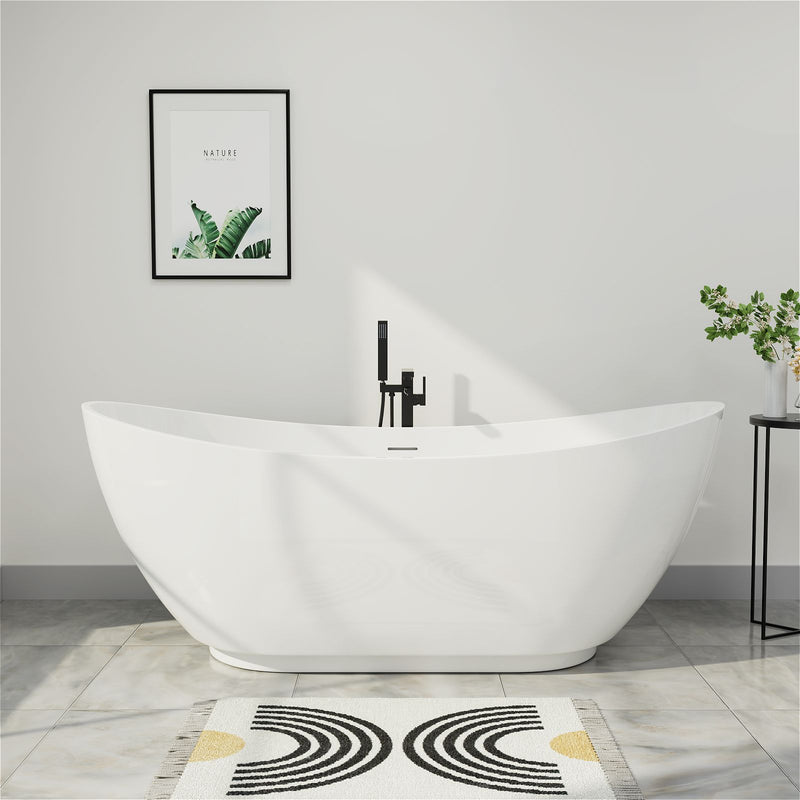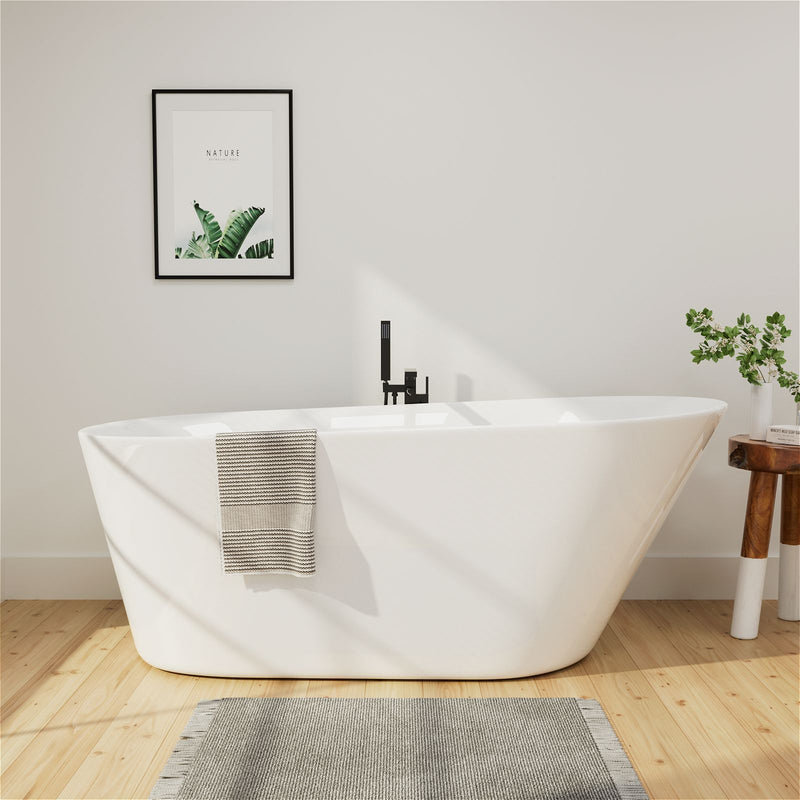A bathtub is an important investment in the comfort and value of your home. Understanding the lifespan of a bathtub and how to properly care for it is essential for homeowners looking to make smart choices when it comes to bathroom fixtures. In this guide, we'll explore the life expectancy of various bathtub materials, factors that affect their lifespan, and some important maintenance tips to help you get the most out of your investment.
How Long Does a Bathtub Last?
Bathtubs typically last 10 to 30 years, depending on the material used. Factors such as care, usage, and the quality of the materials can affect the lifespan of a bathtub. Let's explore the lifespan of the various bathtub materials available on the market.

Fiberglass Bathtubs
Fiberglass bathtubs are popular because they are affordable and lightweight. They are often the first choice for secondary bathrooms. However, fiberglass is thinner and can bend, break, and damage more easily than other materials.
Typically, a fiberglass bathtub has a lifespan of about ten years. The surface of a fiberglass bathtub scratches easily, which increases wear and tear. In addition, scratched surfaces are more difficult and less sanitary to clean.
Acrylic Bathtubs
Acrylic bathtubs are slightly more expensive than fiberglass bathtubs, but they are more durable. These bathtubs are made of multiple layers of clear plastic and reinforced with fiberglass. One of the significant advantages of acrylic bathtubs over porcelain enameled or fiberglass bathtubs is the wide variety of color options. This variety allows you to choose a bathtub that matches your bathroom decor perfectly.
In addition, acrylic bathtubs give a warm and cozy feeling and retain heat better than fiberglass. They are lightweight like fiberglass, but are more resistant to bending, stains, and are less likely to be damaged by cracking or chipping. It is worth noting that the acrylic surface is easily scratched, so it is recommended to use a soft sponge or microfiber towel for cleaning.
The average lifespan of an acrylic bathtub is about 10 to 15 years. However, when combined with high-tech polymer materials, acrylic bathtubs become an affordable and durable option.
Porcelain Enameled Steel Bathtubs
Porcelain enameled steel bathtubs, also known as porcelain enameled cast iron bathtubs, combine economy and durability. Although they may be cheaper than acrylic bathtubs, they are significantly heavier. Porcelain enameled steel bathtubs are made of sturdy materials and are not as prone to bending as fiberglass or acrylic bathtubs.
Porcelain surfaces must be handled with care, as they can be scratched if heavy objects are accidentally dropped. A scratched surface can expose the metal underneath, which can lead to rust. Still, porcelain-coated steel tubs are generally more resistant to scratches and stains than their counterparts.
As long as you take good care of your porcelain-enameled steel tub, it can last at least 20 years. If you want to extend its lifespan even further, consider using a bathtub liner. Tub liners are usually made of molded acrylic or PVC plastic that fits over the surface of the tub and can extend its lifespan by 10 to 15 years.
Enameled Cast Iron Tubs
For those who prefer the look and feel of a porcelain tub and want long-lasting durability, enameled cast iron tubs are a great choice. While they are manufactured in a similar process to enameled steel tubs, cast iron tubs use a stronger, heavier core material. Additionally, cast iron tubs retain heat very well, making them ideal for enjoying a comfortable, hot bath.
It's worth noting that enameled cast iron tubs come in fewer color options than acrylic tubs. Also, similar to steel tubs, heavy objects dropped on porcelain surfaces can cause them to chip or break. If your porcelain bathtub has surface damage, it is recommended that you re-ename it to prevent the underlying metal core from rusting.
Properly maintained, enameled cast iron bathtubs can last for decades, combining durability with timeless elegance. However, due to their heavy weight, it is important to consider the necessary floor support when installing.
Copper Bathtubs
For those seeking a unique bathtub, copper bathtubs are an excellent choice. These bathtubs are handcrafted from copper sheets to create a warm and inviting aesthetic. Known for their excellent heat-retaining properties, copper bathtubs offer a luxurious copper bathtub experience for those seeking a unique bathtub. These bathtubs are handcrafted from copper sheets to create a warm and inviting aesthetic. Known for their excellent heat-retaining properties, copper bathtubs offer a luxurious bathing experience for those seeking a unique bathtub.
Copper bathtubs are extremely durable and can last for decades. A properly maintained copper bathtub can last a lifetime. Over time, the naturally formed patina will give the bathtub a unique character and beauty, enhancing its appeal.
It is important to note that there are many factors that affect the lifespan of a copper bathtub. The thickness of the copper, the level of craftsmanship, and the level of maintenance will all affect its lifespan. Regular cleaning with a mild, non-abrasive detergent and avoiding harsh chemicals will help maintain your tub's finish and extend its life.
Stone Tubs
Made from materials like marble, granite, or travertine, stone tubs offer a timeless, luxurious appeal for those who appreciate the natural beauty of stone. However, there are a few things to consider before choosing a stone tub.
First, stone tubs are much heavier than other types of tubs. This weight can make installation challenging and require additional floor support for stability. Therefore, it's important to consider the potential installation costs of a stone tub.
While stone tubs offer unparalleled elegance, they don't retain heat as well as other materials. This means that water in a stone tub may cool more quickly, shortening your relaxing soak. Stone tubs are best suited for ground-floor bathrooms, where weight and heat retention are less of a concern.
Despite these concerns, the long-lasting durability of stone tubs is worth keeping in mind. With proper care, stone tubs can last a long time and add a touch of sophistication to your bathroom.
When Should You Replace Your Tub?
Knowing when to replace your tub is essential to keeping your bathroom functional and looking great. Here are four signs that your tub may need to be replaced:

Leaks and Cracks
If your tub has cracks, it can be unusable and unsafe. While minor cracks can sometimes be repaired, a leaking tub can be very tricky and can cause wood warping, mold and mildew. Don't ignore even minor leaks, as they can get worse over time.
Stains
While regular cleaning can help remove stains from the surface of your tub, if the surface is damaged, stains become porous and difficult to clean effectively. Not only does stubborn stains detract from the beauty of your tub, it also means it becomes increasingly difficult to maintain hygienic standards in your tub.
Mold and Mildew
Mold and mildew are not only unsightly, they can also be a health hazard. While they're often visible to the naked eye, these harmful microorganisms can also hide in caulk, faucet crevices, or bathroom walls. Mold and mildew are signs that your tub may have underlying moisture issues that need to be addressed.
Comfort and Functionality
Assess your existing tub for comfort and convenience. If you find it uncomfortable or difficult to use, consider replacing it with one that better suits your preferences and needs.
Factors that Affect the Life of a Tub
Quality of Workmanship
The most important factor is the quality of the renovation. An experienced professional who properly treats the surface, uses high-quality renovation materials, and strictly follows all procedures can keep the life of a tub close to the upper limit of 15 years.
Usage Patterns and Wear and Tear
How often and how a tub is used is important. Daily bathing or multiple people using the tub will accelerate the wear and tear of the tub. The weight and movements of the user, as well as items such as bath toys, can damage the surface of the tub over time.
Water Quality
The quality of the water in your home is also important. Hard water has a high mineral content and tends to leave residue and cause scale buildup. This can cause discoloration and damage to the tub. However, soft water is less likely to cause these problems and helps keep the tub in good condition.
Care and Maintenance
How you care for your renovated tub is crucial to its longevity. Regular cleaning with a non-abrasive cleaner and avoiding sharp or heavy objects (to avoid scratching the surface) can extend the life of the tub.
Original Tub Materials
A tub made of certain materials, such as acrylic or fiberglass, may not adhere to refinished products the same way as a tub made of cast iron or porcelain.
Cleaning Tools
Harsh scrubbing tools can damage the surface and shorten its life. Using gentle tools or towels can help you keep the surface smooth and clean.
Environmental Factors
The average temperature and humidity in your area can affect how well the repair material sets and cures. Also, wild fluctuations in the water temperature in the tub can affect the repair over time.
How to Extend the Life of Your Tub
You can extend the life of your tub through regular care and maintenance, as follows:

Stick to mild, non-abrasive detergents for cleaning: Use a cleaner specifically formulated for the material your tub is made of. Avoid steel wool, scouring pads, or hard-bristle brushes, and use soft sponges and rags instead.
Prevent Surface Damage: Shower racks, shelves, shower storage racks, and bath mats that are firmly fixed to the bottom of the tub can prevent items from being accidentally scratched.
Rinse and wipe the tub after each use: After your weekly deep cleaning, it is recommended to rinse and wipe the tub to keep the surface clean.
Reduce Sun Exposure: If your bathroom is exposed to direct sunlight, consider using blinds or shades to protect the tub from UV rays.
Inspect and Repair Chips and Cracks: Regularly inspect the surface of the tub for dents, cracks, and chips, and repair them if found.
Polishing: A soft cloth or soft polishing pad will help polish the tub and keep it waterproof. You can also apply car wax to the sides of the tub in areas prone to wear. (Never apply wax to the bottom of the tub.)
Ensure that the bathroom is well ventilated: Excessive moisture can cause mold to grow in and around the tub, and can also damage the walls and floors that support the tub.
Conclusion
The lifespan of a tub depends on a variety of factors, such as the materials used, maintenance habits, and usage patterns. Knowing when to replace the tub is essential to keeping the bathroom fully functional and hygienically clean. Once signs of leaks, cracks, stubborn stains, mold growth, and discomfort appear, it's time to consider replacing the tub.
Ultimately, the choice of tub material should be based on your preferences, budget, and maintenance capabilities. Proper care, maintenance, and occasional refinishing or reglazing can extend the life of your tub, giving you a relaxing and enjoyable bathing experience for years to come.





